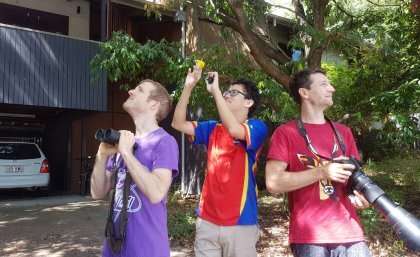

A challenge among three housemates to identify species around their inner-Brisbane home has resulted in an academic research paper, showcasing the rich biodiversity in urban landscapes.
UQ mathematician Dr. Matt Holden, ecologist Dr. Andrew Rogers and taxonomist Dr. Russell Yong took a census of their Annerley share house and its backyard during the COVID-19 lockdowns in 2020, and discovered 1,150 unique species of animals, plants and fungi over a 12-month period.
“We asked a large number of ecologists and conservation scientists how many species they’d expect to find in this setting and they predicted only 200,” Dr. Holden said.
“But after 60 days of surveying, we’d already discovered 777 species.
“It shows suburban houses and apartments could have far more biodiversity than ever imagined, especially when it comes to insects.”
The idea of the species count was born when Dr. Rogers went to vacuum cobwebs in his room and wondered how many spiders were on the property.
“The three of us soon envisioned a plan to comb through the house and backyard in search of other critters that resided alongside us,” Dr. Holden said.
The survey revealed richly biodiverse creatures including 436 moth and butterfly species, 56 different spiders, eight reptiles and 56 birds.

The bird species included tawny frogmouths, laughing kookaburras, blue-faced honeyeaters, rainbow lorikeets, spotted doves and Brisbane favorite, the Australian white ibis.
“Blue-tongued skinks hibernated under the garage and at night blue-banded and teddy-bear bees slept in the hedges under the front window,” Dr. Holden said.
The researchers were also surprised to discover three species not previously recorded in Australia’s leading biodiversity database, Atlas of Living Australia—a mosquito, a sandfly, and an invasive flatworm, Platydemus manokwari, which is responsible for native snail population declines, around the world.
“The house was a complex ecosystem of species interacting—we stumbled upon the moth Scatochresis innumera, which as a caterpillar spends its whole time feeding inside the dung of a Brushtail Possum before emerging as an adult,” Dr. Holden said.
“The Parilyrgis concolor is another moth species whose caterpillar lives in spider webs and devours spider poop to survive.”
Dr. Holden said homes across all urban areas could play host to similar biodiversity.
“It depends on how people tend to their homes and gardens—keeping low maintenance trees and shrubs and eliminating manicured lawns and pesticides will significantly boost the number of critters found,” he said.
“You don’t have to go traveling to connect with Australia’s diverse range of species, just look in your own backyard.”
The research is published in Ecology.
More information:
Andrew M. Rogers et al, The house of a thousand species: The untapped potential of comprehensive biodiversity censuses of urban properties, Ecology (2023). DOI: 10.1002/ecy.4225
Provided by
University of Queensland
Citation:
Three researchers show their suburban backyard is home to more than 1,000 species (2023, December 7)
retrieved 7 December 2023
from https://phys.org/news/2023-12-suburban-backyard-home-species.html
This document is subject to copyright. Apart from any fair dealing for the purpose of private study or research, no
part may be reproduced without the written permission. The content is provided for information purposes only.





